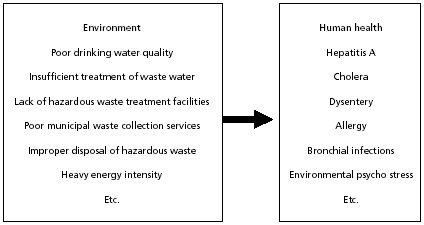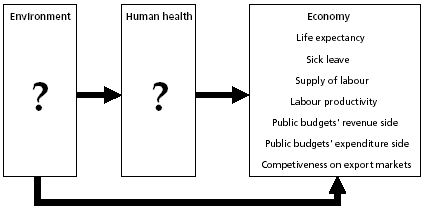|
Environment in Ukraine - Problems and Challenges 4. Summary, Conclusions and Perspectives
4.1 IntroductionUkraine has struggled with a legacy of pollution since the dissolution of the Soviet Union in 1991. It has not been in vain but achievements are scarce. In this chapter we provide a summary of the identified environment related problems and challenges in Ukraine and highlight the major conclusions. Furthermore, we look upon the perspectives. Special attention is paid to the relationship between environment, human health and economic growth. 4.2 SummaryTable 4.1 provides a summary of the problems and challenges dealt with in Chapter 3. Only the most important problems and challenges are mentioned. 4.3 ConclusionsIt seems possible to draw five conclusions. These are highlighted in following. Several ticking bombs exist The deterioration of the physical infrastructure is so alarming that several ticking bombs exist. In some regions it seems on the point of collapse. This is true for all three sectors dealt with in this report (water, waste and energy sectors). Within the water sector, there is a danger that large-scale contamination of potable water will occur due to leaking sewers. Within the waste sector, storage of hazardous waste on environmentally unsafe, not properly protected sites may lead to serious contamination of water resources, including surface waters, such as lakes. Within the energy sector, an accident may occur on one of the outmoded nuclear power plants. These are only a few examples of ticking bombs. Some will mainly affect Ukraine and only Ukraine. Others may affect Europe. Table 4.1
Adverse impacts on environment and human health – and economy The environmental problems in Ukraine are causing serious adverse impacts on environment and human health and can further, which is important as well, be regarded as impediments to a social and economic development in the country. No doubt the problems within the waste, water and energy sectors have serious adverse impacts on environment and human health. This is sought illustrated in Figure 4.1 below. Much pollution impacts on human health through water, either directly or indirectly. Besides, it constitutes an important rationale for the EU Water Initiative, which was proclaimed at the Johannesburg Summit in 2002. This initiative aims at ensuring good drinking water quality and sanitation services to people in a reliable, sustainable manner and at least cost.
Figure 4.1 Just as important are the links that exist between environment and human health on one side and the economy on the other side. Impacts on economy may be positive or negative. What we do know is that impacts exist. This is sought illustrated in Figure 4.2 below. Please note that it has been simplified a little insofar as reverse arrows from the economy have been omitted. Certainly, an economic recovery may – if it is associated with appropriate structural reforms – help generate resources for investment in cleaner technologies, reduce the share of pollution-intensive heavy industries in economic activity and help curb pollution as part of the shift towards more efficient production methods. Ultimately, economic growth associated with environmental degradation endangers the economic growth itself. This is a commonplace remark. Nevertheless, there is a need in Ukraine to reach broad public understanding of this.
Figure 4.2 Important steps may be taken now – provided there is a political will It is possible for the Ukrainian Government, including the MENR, to take some important steps now to improve environmental management – provided there is a political will. Many of the challenges within the water, waste and energy sectors do not require further research. Nor do they entail huge investment costs. In fact, some reforms may lead to cost savings, at least in the medium to long term. The example par excellence on this seems to be a reform of monitoring. A most important step to take is to prepare, approve and implement required changes in the basic requirements within environmental management; that is, the standards and permits. These may be changed fairly easy using EU Directives as benchmarks. A reform of the standard setting and permitting systems is of utmost importance insofar as the supporting actions (monitoring, enforcement and compliance) heavily depend upon these systems. Existing systems date back to the Soviet Union. They were meant for propaganda purposes in the 80’s, and they were (and are) seen as a revenue source – sometimes legal, sometimes illegal – for research institutes and public officials in the 90’s. In fact, they have never aimed at ensuring effective environmental management.
Upgrading of the physical infrastructure requires huge investments, which is impossible to finance, unless additional financial sources – either foreign or domestic – are found. If the task is to ensure an upgrade to EU standards an astronomic figure arises. However, even if the task is less ambitious a high figure arises. Total capital cost requirements mentioned in this report amount to EUR 50-60 billion, corresponding to EUR 1000-1250 per capita. For comparison the GDP per capita amounted to approximately EUR 800 in 2002. There is no doubt that foreign sources will play only a marginal role. That is, Ukraine has to rely on domestic sources for environmental financing. It is, however, possible to increase domestic sources for environmental financing substantially. Progress in this respect is largely dependent on appropriate reforms being implemented, foremost reform of fee and tariff setting, introduction of full cost recovery and improvement of utilities’ management and operation. Furthermore, it is possible to make more efficient use of existing resources through, for instance, improved financial planning. Thus, domestic sources for environmental financing need not be as scarce as they are today. Much depends on further progress in the reform process as a whole The problems highlighted in this report will take no politicians, public officials or NGOs involved in environmental policy-making in Ukraine by surprise. Also the challenges are well known. The question therefore is: How comes that effective environmental management has not yet been developed and implemented? The immediate answer is the lack of environmental policy capacity. The more fundamental answer is that much depends on the reform process as a whole. Almost all of the weaknesses mentioned in Chapter 2 regarding the environmental management set-up are not only of relevance for the environmental management. Likewise, the lack of environmental policy capacity and the reasons for this do not only concern (or affect) environmental management. Unfortunately, the reform process has not yet gained momentum, as is the case in, for instance, Russia. In Ukraine, the political economy equilibrium that was established in the wake of 1991, when it gained independence, still exists. The big challenge to Ukraine and Ukrainians is to break this. However, as mentioned by the World Bank: "Breaking the political economy equilibrium underlying state capture and partial reforms is the most important and difficult challenge in advancing the transition in countries with concentrated political regimes (such as Ukraine, ed.)"6. 4.4 PerspectivesTwo extreme scenarios are possible in the short to mid term, namely Business-As-Usual, where no major changes of relevance to the environmental policies occur, and Miracle, where effective environmental policies are not only developed but also implemented. Probably, the actual development path in the next 5-10 years will be something in between these two extreme scenarios. One important source of reform in Ukraine, including reform of environmental management, is EU accession. Even though Ukraine is not an EU accession country its European aspirations are high, not only but also within the Ukrainian Government. This gives ground to some kind of optimism for the future. Foreign donors, whether multilateral or bilateral, may do a lot to ensure that Miracle will come through. They may launch projects that combine technical assistance with investments. Preferably, the projects should pay much attention to public awareness, information dissemination and public participation. The Aarhus Convention could be touched upon with several projects, even projects that are mainly investment projects. Furthermore, foreign donors may launch projects that aim at supporting required changes in legal and regulatory frameworks thereby increasing the environmental policy capacity of Ukraine. It seems important that foreign donors monitor progress made carefully, foremost regarding the environmental policy capacity, and subsequently reward achievements made by the Ukrainian Government, including the MENR. The extent to which Ukraine moves along the development path Miracle may be judged upon on the basis of the monitoring of a set of performance indicators. This set could be developed on the basis of the Environmental Strategy developed by the NIS countries up to the 5th "Environment for Europe" Ministerial Conference. The following performance indicators could be included:
The regular environmental performance reviews prepared under the auspices of the UNECE/OECD could be used for the monitoring of the progress made. Following the explosion and core meltdown of one of the reactors at the Chernobyl’ nuclear power plant in the northern part of Ukraine in April 1986, the country did hit the headlines all over the world. The present state of environment in the country is so serious that an environmental catastrophe may happen again unless dedicated action is taken as soon as possible, foremost by Ukraine itself. The outside world can help a lot – by exercising a well-documented pressure on Ukraine for an improvement of the environmental management set-up and also rewarding achievements made. But it cannot do more than that. When all comes to an end, a change in course rests upon Ukraine itself.
|
|||||||||||||||||||||||||||||||||||||||||||||||||||||||||||||||||||||||||||||||||||||||||||||||||||||||||||||||||||||||||||||||||||||||||||||||||||||||||

